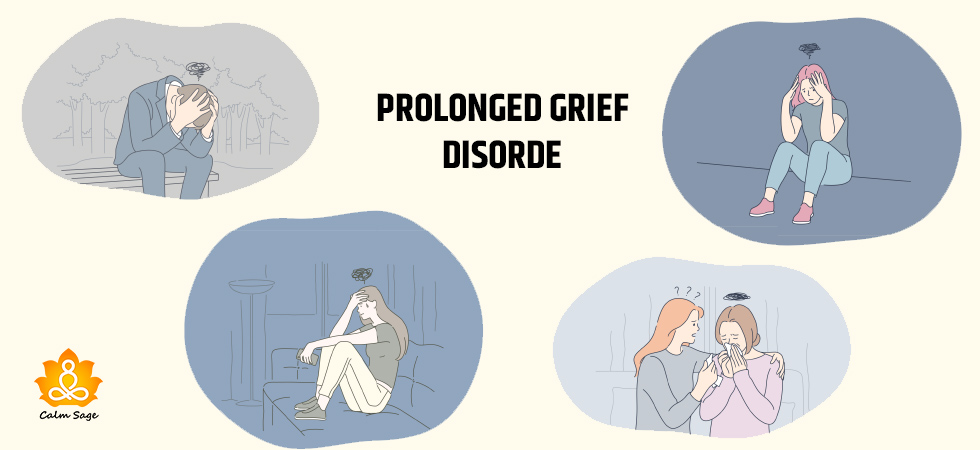Prolonged Grief Disorder Recently Added To DSM-5: Understanding The Updates of DSM-5

The Diagnostic and Statistical Manual of Mental Disorders (DSM-5) is known to be the standard manual used for mental health diagnosis and for planning the treatment of such conditions by professionals. In March 2022, DSM-5 was updated by the American Psychiatric Association (APA) for adding clarity to some mental health conditions.
The updated text version is titled the Diagnostic and Statistical Manual of Mental Disorder Text Revision (DSM-5-TR). In the text revision of DSM-5, APA has added prolonged grief disorder as a condition. Along with the addition, symptoms codes for non-suicidal self-injury and suicidal behavior are also added. The editors of the DSM-5 described these changes as important for researchers, clinicians, and mental health advisors.
In this blog, let’s discuss why prolonged grief disorder is updated as a condition in the DSM-5 along with the other updates of DSM-5-TR announced by APA. So, let’s get started.
What is Prolonged Grief Disorder?
Prolonged Grief Disorder (PGD) is a syndrome where grief overpowers an individual. It mostly happens to people dealing with the death of a loved one.
Since the prolonged grief disorder is long-lasting and a disruptive type of grief, it was important to add this condition to the DSM-5. After this update, clinicians will be finally able to diagnose this condition formally.
The fact is that everyone’s grieving time and process are different and some clinicians and psychologists are not satisfied with the update. According to Noel Hunter, “this is yet another disgusting display of overreach, pharmaceutical influence, and an inability as a society to tolerate painful emotions. The updates to the DSM are, sadly, representative of a process that has been troubled from the start.”
According to Hunter, the trouble is referred to the financial conflicts. Hunter also stated that “It is abysmal and reprehensible to attempt to justify pathologizing someone for their process of grief.”
Meanwhile, Gayle Weill (Clinical Social Worker) showed mixed feelings towards the update, “On the other hand, everyone reacts to loss differently.” “I worry with having this new diagnosis that it will be misdiagnosed for someone who is going through a natural process—that of missing a dearly departed loved one.”
Karin Gepp (Clinical Psychologist) stated, “I think these (clients) would generally get lumped into adjustment disorders or depression diagnoses.” “But studies have shown that 1 in 10 adults may experience prolonged grief –especially now, with this pandemic having killed so many people suddenly, this is a really important addition.”
Why it was necessary to add Prolonged Grief Disorder in DSM-5?
This addition is believed to be important for the diagnosis and process. Accordingly, we should all agree with the statements of Karin Gepp. Two years of pandemic and ongoing issues were intense and most people experienced an extended period of grief or loss. Many of us are still processing our grieving. If you will observe properly, the update of the DSM-5 has its significance due to the perfect timings of release.
According to Iris Waichler, “Covid-19 created new emotional hardships for many people who have suffered additional layers to their grief.” “They were unable to be with their loved ones and unable to say goodbye to them in person…the fact that none of this was possible directly impacts how their grief was experienced.”
Indeed, the pandemic took away the possibility to hold the hand of our loved ones during hardship, and additionally, most of us were not able to have rituals and services that help us cope with the loss. The impact of Covid-19 is going to take time.
What are the other updates in DSM-5-TR?
Reinstating Unspecified mood disorder
The DSM-5 has removed “unspecified mood disorder” as a condition and diagnosis in 2013. However, reinstating unspecified mood disorders will allow clinicians to observe more specific symptoms for providing diagnosis and prescription.
Non-suicidal self-harm
The DSM-5 has also added self-harm without the occurrence of suicidal thoughts to the diagnosis list.
Importance of gender-inclusive language
The DSM-5 also included possible changes to the language nearby gender identity. the significance of this update is to decrease the stigmas lying around gender-inclusive language. The changes are:
- “desired gender” to “experienced gender”
- “cross-sex medical procedure” to “gender-affirming medical procedure”
- “natal male/native female” to “individual assigned male/female at birth”
Focus on race and discrimination
Roberto Lewis-Fernandez (Professor at Columbia University) reviewed the DSM based on equity. And he also focused on making important changes to race and discrimination. Accordingly, committee members are already working to implement appropriate changes. He mentioned, “The role of social determinants of mental health has been increasingly recognized in recent years, DSM-5-TR started to incorporate this information but there is still more that needs to be done in this area.”
I hope this blog helps you to understand why prolonged grief disorder is added to the DSM-5 along with the other updates of DSM-5-TR. For more such content, connect with us on all social media platforms.
Thanks for reading!




















